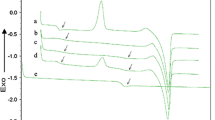Abstract
Purpose. To assess the miscibility and phase behavior of binary blendsof hydroxypropylmethyl cellulose (HPMC) with hydroxypropylcellulose (HPC), methylcellulose (MC), and polyvinylpyrrolidone (PVP).
Methods. Polymer-polymer miscibility was assessed by measurementof the glass transition temperature (Tg) and the width of the glasstransition temperature (W-Tg), using modulated temperaturedifferential scanning calorimetry (MTDSC).
Results. HPMC K4M/PVP and HPMC E5/MC blends were miscibleas evidenced by a single, composition dependent, Tg throughout theentire composition range. HPMC/HPC blends were immiscible at allcompositions. For the miscible blends, the variation in Tg with blendcomposition was compared to the values predicted by the Fox andCouchman-Karasz equations. At intermediate blend compositions,HPMC K4M/PVP blends exhibited negative deviations from idealbehavior. The Tg of the HPMC E5/MC blends was found to followthe Fox equation. The W-Tg measurements of the miscible blends gaveevidence of phase separation at certain compositions.
Conclusions. MTDSC was shown to be a useful technique incharacterizing the interactions between some commonly used pharmaceuticalpolymers.
Similar content being viewed by others
REFERENCES
P. Sakellariou and R. C. Rowe. Interactions in cellulose derivative films for oral drug delivery. Prog. Polym. Sci. 20:889–942 (1995).
H. Huatan, J. H. Collett, and D. C. Attwood. The microencapsulation of protein using a novel ternary blend based on poly(epsilon-caprolactone). J. Microencapsul. 12:557–567 (1995).
M. Tobio, J. Nolley, Y. Guo, J. McIver, and M. J. Alonso. A novel system based on a poloxamer/PLGA blend as a tetanus toxoid delivery vehicle. Pharm. Res. 16:682–688 (1999).
Y. Morita, H. Saino, and K. Tojo. Polymer blend implant for ocular delivery of fluorometholone. Biol. Pharm. Bull. 21:72–75 (1998).
O. Olabisi, L. M. Robeson, and M. T. Shaw. Poylmer-Polymer Miscibility, Academic Press, New York, 1979.
M. Song, A. Hammiche, H. M. Pollock, D. J. Hourston, and M. Reading. Modulated differential scanning calorimetry: 4. Miscibility and glass transition behavior in poly(methylmethacrylate) and poly(epichlorohydrin) blends. Polymer 37:5661–5665 (1996).
A. Hale and H. E. Blair. Polymer blends and block copolymers. In E. A. Turi (ed.), Thermal Characterization of Polymeric Materials, (2nd Ed.), Academic Press, San Diego, 1997, pp. 745–886.
B. Wunderlich. The basis of thermal analysis. In E. A. Turi (ed.), Thermal Characterization of Polymeric Materials, (2nd Ed.), Academic Press, San Diego, 1997, pp. 205–482.
M. Reading, D. Elliot, and V. L. Hill. A new approach to the calorimetric investigation of physical and chemical transitions. J. Therm. Anal. 40:949–955 (1993).
N. J. Coleman and D. Q. M. Craig. Modulated temperature differential scanning calorimetry: A novel approach to pharmaceutical thermal analysis. Int. J. Pharm. 135:13–29 (1996).
E. Doelker. Cellulose derivatives. Adv. Polym. Sci. 107:200–265 (1993).
M. Song, A. Hammiche, H. M. Pollock, D. J. Hourston, and M. Reading. Modulated differential scanning calorimetry: 1. A study of the glass-transition behavior of blends of poly(methyl methacrylate) and poly(styrene-co-acrylonitrile). Polymer 36:3313–3316 (1995).
B. C. Hancock and G. Zografi. The relationship between the glass transition temperature and the water content of amorphous pharmaceutical solids. Pharm. Res. 11:471–477 (1994).
H. N. Joshi and T. D. Wilson. Calorimetric studies of dissolution of hydroxylpropyl methylcellulose E5 (HPMC E5) in water. J. Pharm. Sci. 82:1033–1038 (1993).
D. T. Turner and A. Schwartz. The glass transition temperature of poly(N-vinyl pyrrolidone) by differential scanning calorimetry. Polymer 26:757–762 (1985).
K. M. Picker. Hydrophile Matrixtabletten: Tablettierung und Freisetzung-unter besonderer Berücksichtigung der relativen Feuchte während der Herstellung. Doctoral Thesis. University of Hamburg (1995).
T. G. Rials and W. G. Glasser. Thermal and dynamic mechanical properties of hydroxypropyl cellulose films. J. Appl. Polym. Sci. 36:749–758 (1988).
T. T. Kararli, J. B. Hurlbut, and T. E. Needham. Glass-rubber transitions of cellulosic polymers by dynamic mechanical analysis. J. Pharm. Sci. 79:845–848 (1990).
S. Suto, M. Kudo, and M. Karasawa. Static tensile and dynamic mechanical properties of hydroxypropylcellulose films prepared under various conditions. J. Appl. Polym. Sci. 31:1327–1341 (1986).
V. Davè, M. Tamagno, and B. Focher. Hyaluronic Acid-(Hydroxypropyl)cellulose blends: A solution and solid state study. Macromolecules 28:3531–3539 (1995).
P. Sakellariou, R. C. Rowe, and E. F. T. White. The thermoanalytical properties and glass transition temperatures of some cellulosic derivatives used in film coating. Int. J. Pharm. 27:267–277 (1996).
L. S. Taylor and G. Zografi. Sugar-polymer hydrogen bond interactions in lyophilized amorphous mixtures. J. Pharm. Sci. 87:1615–1621 (1998).
Methocel cellulose ethers handbook. Dow Chemical Company, Midland, MI (1997).
C. Alvarez-Lorenzo, R. A. Lorenzo-Ferreira, J. L. Gó mez-Amoza, R. Martínez-Pacheco, C. Souto, and A. Concheiro. A comparison of gas-liquid chromatography, NMR spectroscopy and Raman spectroscopy for determination of the substituent content of general non-ionic cellulose ethers. J. Pharm. Biomed. Anal. 20:373–383 (1999).
R. J. Samuels. Solid-state characterization of the structure and deformation behavior of water-soluble hydroxypropyl cellulose. J. Polym. Sci., Polym. A-2. 7:1197–1258 (1969).
Klucel. Hydroxypropylcellulose. Physical and chemical properties. Hercules Incorporated, Wilmington, DE (1997).
S. Lau, J. Pathak, and B. Wunderlich. Study of phase separation in blends of polystyrene and poly(α-methylstyrene) in the glass transition region using quantitative thermal analysis. Macromolecules 15:1278–1283 (1982).
J. Roovers and P. M. Toporowski. Rheological study of miscible blends of 1,4-polybutadiene and 1,2-polybutadiene (63% 1,2). Macromolecules 25:1096–1102 (1992).
T. G. Fox. Influence of diluent and of copolymer composition on the glass transition temperature of a polymer system. Bull. Am. Phys. Soc. 1:123 (1956).
P. R. Couchman and F. E. Karasz. A classical thermodynamic discussion of the effect of composition on glass-transition temperatures. Macromolecules 11:117–119 (1978).
Author information
Authors and Affiliations
Rights and permissions
About this article
Cite this article
Nyamweya, N., Hoag, S.W. Assessment of Polymer-Polymer Interactions in Blends of HPMC and Film Forming Polymers by Modulated Temperature Differential Scanning Calorimetry. Pharm Res 17, 625–631 (2000). https://doi.org/10.1023/A:1007585403781
Issue Date:
DOI: https://doi.org/10.1023/A:1007585403781




